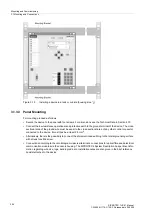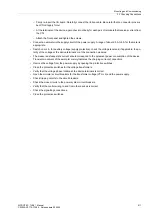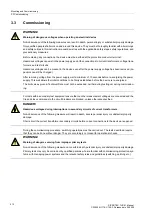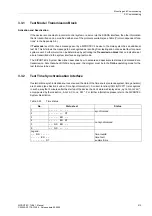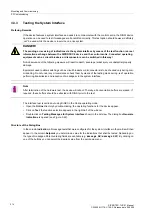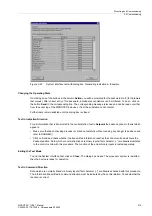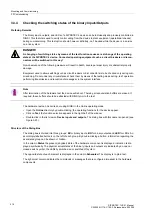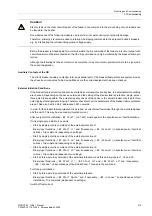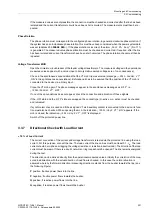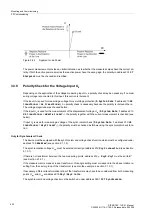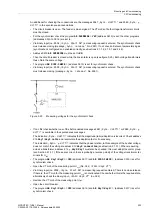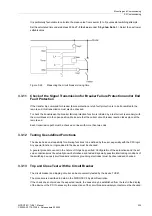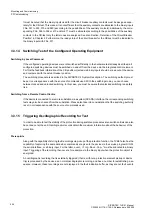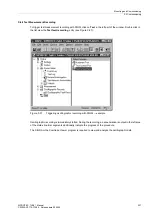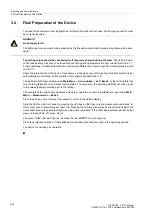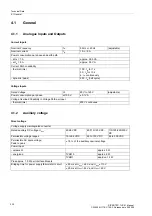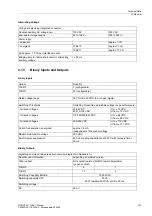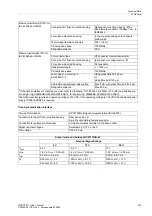
Mounting and Commissioning
3.3 Commissioning
SIPROTEC, 7VK61, Manual
C53000-G1176-C159-3, Release date 05.2009
220
If start is possible without current flow:
• Starting by trip command of the external protection without current flow:
Binary input functions
„>BF Start w/o I“
and, if necessary,
„>BF release“
(in spontaneous or fault
indications). Trip command (dependent on settings).
Busbar Tripping
The most important thing is the check of the correct distribution of the trip commands to the adjacent circuit
breakers in case of breaker failure.
The adjacent circuit breakers are those of all feeders which must be tripped in order to ensure interruption of
the fault current should the local breaker fail. These are therefore the circuit breakers of all feeders which feed
the busbar or busbar section to which the feeder with the fault is connected.
A general detailed test guide cannot be specified because the layout of the adjacent circuit breakers largely
depends on the system topology.
In particular with multiple busbars the trip distribution logic for the surrounding circuit breakers must be
checked. Here check for every busbar section that all circuit breakers which are connected to the same busbar
section as the feeder circuit breaker under observation are tripped, and no other breakers.
Tripping of the Remote End
If the trip command of the circuit breaker failure protection must also trip the circuit breaker at the remote end
of the feeder under observation, the transmission channel for this remote trip must also be checked. This is
done together with transmission of other signals according to Sections „Testing of the Teleprotection Scheme
with ...“ further below.
Termination of the Checks
All temporary measures taken for testing must be undone, e.g. especially switching states, interrupted trip com-
mands, changes to setting values or individually switched off protection functions.
3.3.6
Current, Voltage, and Phase Rotation Testing
≥
10 % of Load Current
The connections of the current and voltage transformers are tested using primary quantities. Secondary load
current of at least 10 % of the nominal current of the device is necessary. The line is energized and will remain
in this state during the measurements.
With proper connections of the measuring circuits, none of the measured-values supervision elements in the
device should pick up. If an element detects a problem, the causes which provoked it may be viewed in the
Event Log.
If current or voltage summation errors occur, then check the matching factors (see Section 2.1.3.1).
Messages from the symmetry monitoring could occur because there actually are asymmetrical conditions in
the network. If these asymmetrical conditions are normal service conditions, the corresponding monitoring
functions should be made less sensitive (see Section 2.7.1.6) .
Quantities
Currents and voltages can be viewed in the display field on the front of the device or the operator interface via
a PC. They can be compared to the actual measured values, as primary and secondary quantities.
Summary of Contents for Siprotec 7VK61
Page 8: ...Preface SIPROTEC 7VK61 Manual C53000 G1176 C159 3 Release date 05 2009 8 ...
Page 14: ...Contents SIPROTEC 7VK61 Manual C53000 G1176 C159 3 Release date 05 2009 14 ...
Page 316: ...Literature SIPROTEC 7VK61 Manual C53000 G1176 C159 3 Release date 05 2009 316 ...
Page 328: ...Glossary SIPROTEC 7VK61 Manual C53000 G1176 C159 3 Release date 05 2009 328 ...

